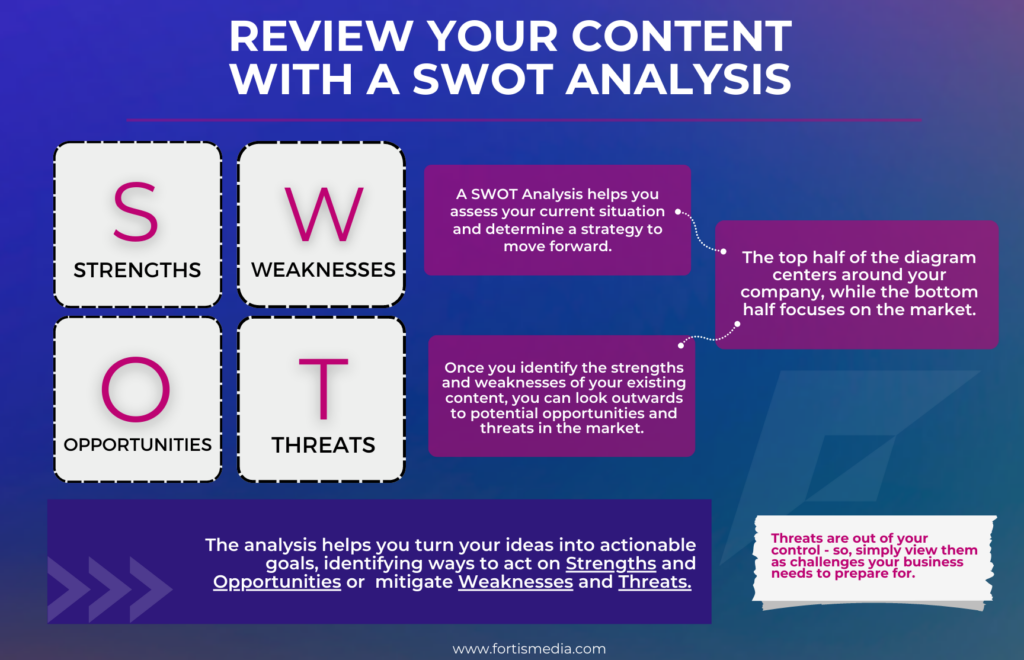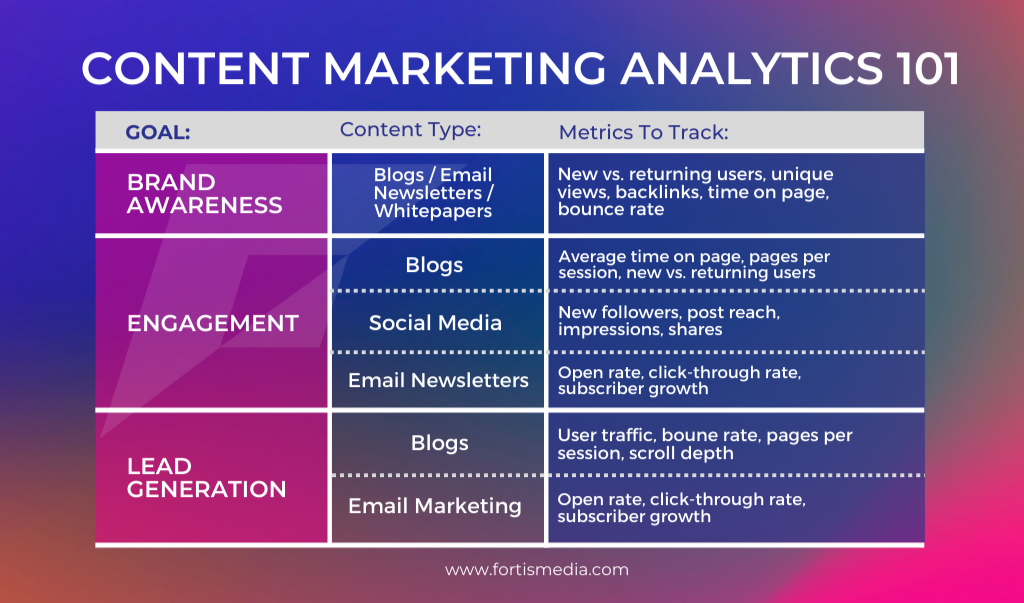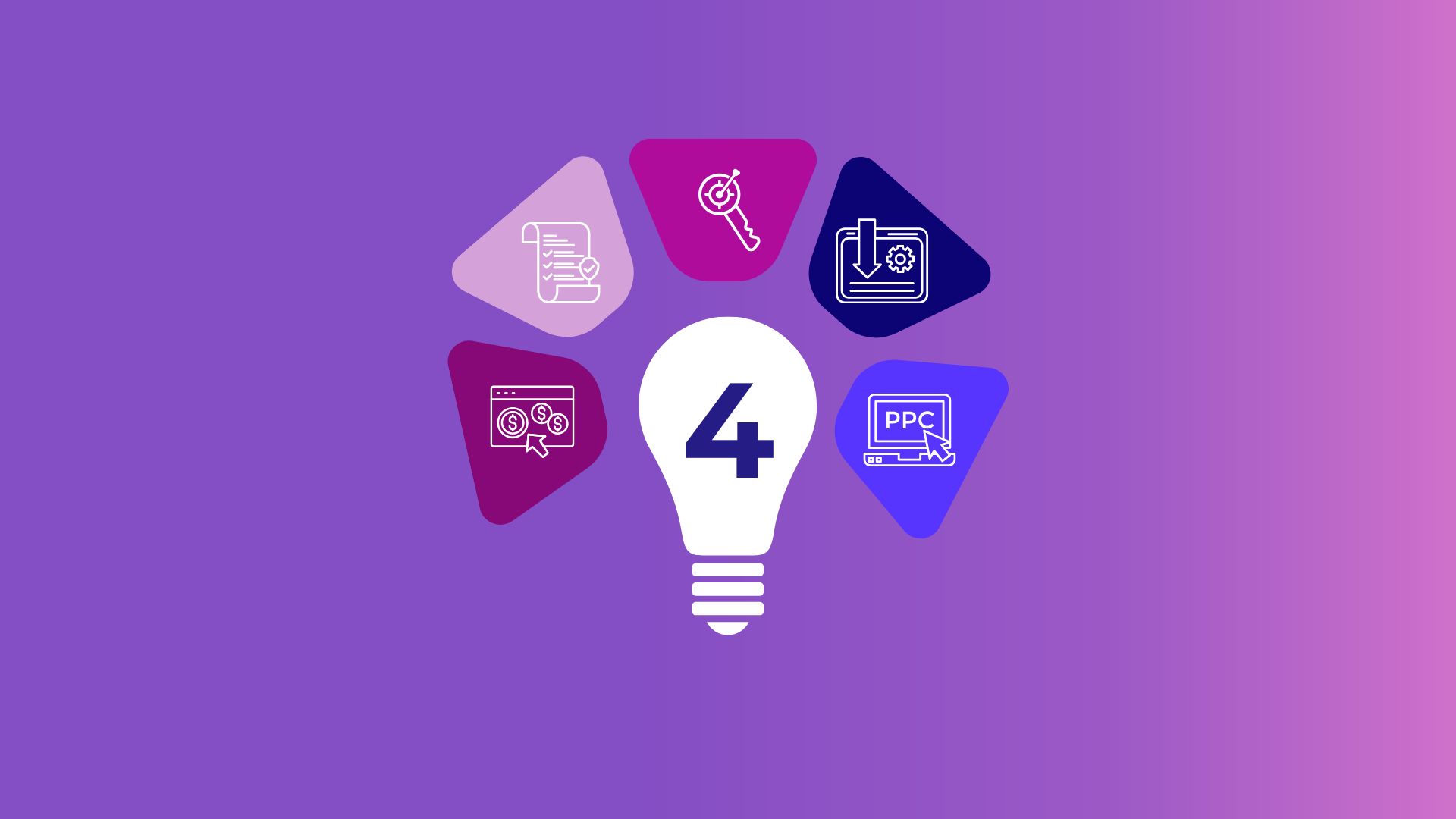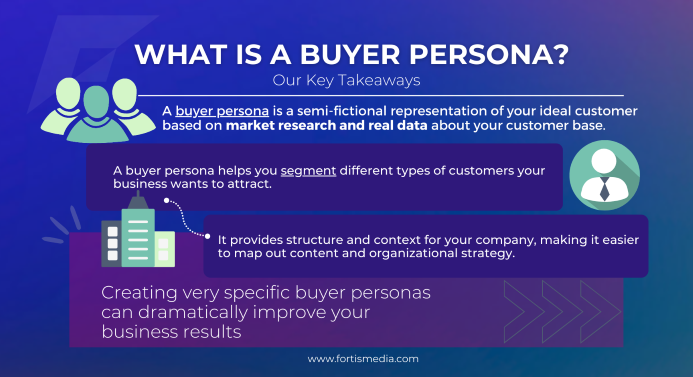How to Stand Out and Succeed at Content Marketing

Assess Your Content With a SWOT Analysis
Before you start producing content from scratch, you need to look at your past work.
Running a SWOT analysis helps you identify the Strengths, Weaknesses, Opportunities, and Threats of your existing content. It allows you to filter the good and the bad, identifying potential gaps – both internal and external – that you can target in your future goals.
The top half of the SWOT analysis entails Strengths and Weaknesses, which center around your company. The bottom half, Opportunities and Threats, focuses outwards to the market – namely your competition and general market trends.
Here’s how to identify the 4 components of the diagram:

Strengths
What do you do well? What content do your customers come back to? List 3-4 major strengths of your current content efforts, identifying winning campaigns, tactics, and skills.
Think about a specific type of content that your audience enjoys to drive this conversation. Examining specific goals that you’ve reached is a great starting point.
To expand on the strengths, determine how you managed to hit your target projections. Examining top-performing content, ask yourself which commonalities you see among them and what readers have positively reacted to.
Based on what has already worked already, you can write valuable blog posts in the future.
Weaknesses
Whether it’s improperly targeted audiences or poorly executed campaigns, your weaknesses prevent you from achieving your marketing goals.
So, think about content initiatives that are either unsuccessful or underperforming. You can identify the weaknesses by asking the following questions:
- What can be improved?
- What resources or tools could improve our performance?
- How do we stand out from our competitors?
Opportunities
How do you differentiate yourself from your competition? The real goldmine of content opportunities can be found within your existing pages.
Simply peruse your top pages and rank them by organic traffic. Once you do that, ask yourself how you could transform them into greater opportunities.
Connecting your top-performing content to larger trends, consider how your company fits into today’s digital landscape. You may consider new tactics that are widely recognized in the industry or tap into emerging content channels that your audience relates to.
You may even tap into new markets to extend your reach – the opportunities are endless!
Threats
How well do you deal with the ever-changing world of content marketing? Can you keep up with the pace at which it’s evolving?
In today’s content marketing landscape, what is trendy one year is out-of-date in another. This, alongside other threats, can undermine your marketing efforts, making it harder to break through the clutter.
While you can’t necessarily control or remove threats, you must find a way to deal with them.
Tailor your content to the buyer persona
Your buyers come from various backgrounds and experiences – your content needs to reflect that.
Many marketers underestimate the work involved in constructing a buyer persona. Yet, it is one of the most important parts of any content strategy. Generic content fails to speak to your target consumer, as it’s misaligned with their interests, backgrounds, and experiences.
The buyer persona allows you to detect common trends, behaviors, and patterns among your customers. It helps you tailor your marketing strategy around their objectives, pain points, and roadblocks.

- Credits: https://blog.hubspot.commarketingbuyer-persona-research
Keep in mind that basic information, such as age and region, is only half the picture. To construct the ideal buyer persona, you should delve deep into buyer motivation – particularly, why your customers buy certain products, or rather why they refrain from them.
To understand why your customers are buying, you can collect psychographic data, which includes your buyers’ values, beliefs, and attitudes. The data contains all the personality elements that make your customers who they are.
Collecting psychographics is not hard – they’re already at your fingertips! Be it customer reviews, social media comments, or Q&A sessions, customers express themselves in many ways. Yet, you can go deeper than surface-level interactions with your audience.
To obtain more information, you can launch surveys as a part of your email flow or host a focus group. This way, you can truly understand who your customers are, what they like to do, and what products they purchase or even dislike.
Remember that people crave inspiration, humor, and excitement. Your content should account for your customer’s needs, meeting them where they are at. With psychographic insights, you can create distinct and meaningful content that resonates deeply with your customers.
Given that, once you paint an accurate picture of your buyer persona, you are ready to convey relevant brand messages to each and every customer. Adapting your content to their interests will surely keep them coming back.
Create Quality Content Your Audience Loves to Engage with
We’re currently experiencing the content gold rush. To stand out from your competition, your content needs a unique spin.
Here are some tips to make your blog content stand out:
Keep The Buyer Persona In Mind
When coming up with a topic for your blog post, think about your buyer’s interests. Does your blog post answer their questions or spark their curiosity?
Focus on adding value for your audience – give solutions, provide answers, and forge meaningful connections. This way, you will build a community around your brand and boost genuine engagement.
Personalize Your Content
Think of content as your brand’s spokesperson who meets your buyer at every step of their journey. What does your buyer think about when deciding what to buy? Does your content address their unique needs?
It takes a whole lot of convincing to turn your visitors into customers. Yet, with the right kind of content, you can drive purchases without coming off as too promotional.
Personalized content is key, as it grows you closer to the customer without using the same cookie-cutter content. In fact, 78% of U.S. internet users report increasing their intent to purchase after consuming personally relevant content.
With that said, consider the buyer’s pain points and craft problem-solution content that equips them with helpful information. Make sure you research their goals and write like you’re a helpful friend.
Alternatively, develop captivating content that grabs the attention of potential customers in the awareness stage. This way, you’ll retain the consumers who land on your website.
So, whether it’s value-packed educational posts or well-detailed How-To’s, personalized content is exceptionally relevant to the user. Ultimately, it shows them how much you value them. Putting your buyer at the center, such content is sure to lead to that final click.
Track The Metrics
To measure your success, it’s important to check whether your efforts are working. Paying attention to the metrics and data will help you identify campaigns, channels, and tools that drive the most value to your business.
Your visitors will show what they’re interested in based on how they interact with your content. As you watch how they respond, you can adjust your content to their needs, breathing new life into your existing marketing efforts.
Here are some of the metrics we recommend tracking:

Tell Stories That People Relate To
Some users are looking for information about your services. Some are looking for meaningful stories about your brand that grip them.
According to the Content Marketing Institute, content marketing is the process behind “distributing relevant and valuable content to attract, acquire, and engage a clearly defined target audience.” This makes storytelling the greatest differentiator for your online presence.
Stories have the power to turn visitors into dedicated fans, boosting everything from brand awareness to conversions. They not only attract but also retain customers, creating long-lasting emotional bonds with them.
With the help of the buyer persona, you can come up with stories that will move your audience. Creating in-depth, touching, and relatable content is sure to sustain long-term engagement and brand loyalty.
Conclusion
The purpose of content marketing lies in establishing strong relationships with the target audience. It is an integral part of building brand loyalty and generating quality leads.
A well-optimized content strategy provides customers with the right content via the right channel at the right time.
Conducting a thorough SWOT analysis and tailoring content to the target consumer deliver significantly better results than traditional push marketing. With relatable stories around your brand, content marketing can amplify your digital presence.
Are you ready to take your content to the next level? Learn how we help businesses scale their sales every day through content marketing at Fortis Media.
Read our other articles

4 PPC Expert Tips for Your Online Casino


Understanding iGaming Affiliate Marketing: A Comprehensive Guide


Is Gambling Legal in Tennessee? Understanding the Legal Status of Gambling







